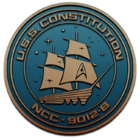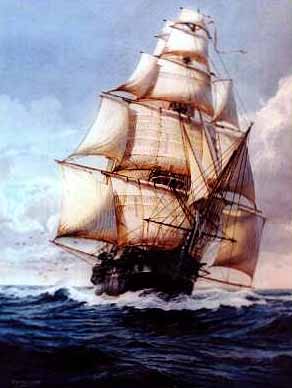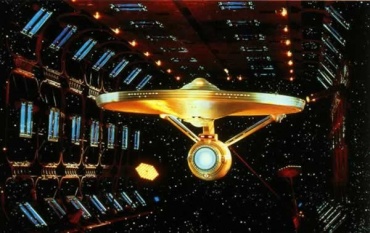Previous ships called Constitution: Difference between revisions
mNo edit summary |
m (changed category) |
||
| Line 12: | Line 12: | ||
Humphreys recognized the need to stiffen the hull to resist the forces causing hogging. The successful integration of the two design criteria demanded an innovated technical solution to the problems of strength of materials and hull design. Built in Boston of resilient live oak, Paul Revere forged the copper spikes and bolts that held the planks in place and the copper sheathing that protected the hull. Thus armed, she first put to sea in July 1798 and saw her first service patrolling the southeast coast of the United States during the Quasi-War with France. In 1803 she was designated flagship for the Mediterranean squadron under Captain Edward Preble and went to serve against the Barbary States of North Africa. | Humphreys recognized the need to stiffen the hull to resist the forces causing hogging. The successful integration of the two design criteria demanded an innovated technical solution to the problems of strength of materials and hull design. Built in Boston of resilient live oak, Paul Revere forged the copper spikes and bolts that held the planks in place and the copper sheathing that protected the hull. Thus armed, she first put to sea in July 1798 and saw her first service patrolling the southeast coast of the United States during the Quasi-War with France. In 1803 she was designated flagship for the Mediterranean squadron under Captain Edward Preble and went to serve against the Barbary States of North Africa. | ||
By early 1812, relations with Great Britain had deteriorated and the Navy began preparing for war, which was declared June 20. Cruising off the Gulf of St. Lawrence on 19 August under the command ofCaptain Isaac Hull, Constitution encountered the Guerriere | By early 1812, relations with Great Britain had deteriorated and the Navy began preparing for war, which was declared June 20. Cruising off the Gulf of St. Lawrence on 19 August under the command ofCaptain Isaac Hull, Constitution encountered the Guerriere, a fast British frigate mounting 49 guns. Twenty minutes later Guerriere was a dismasted hulk, so badly damaged that she was not worth towing to port. Hull had used his heavier broadsides and his ship's superior sailing ability, while the British, to their astonishment, saw that their shot seemed to rebound harmlessly off Constitution's hull - giving her the nickname "Old Ironsides". It was a dramatic victory for America and for Constitution. In this battle of only half an hour the United States "rose to the rank of a first-class power"; the country was fired with fresh confidence and courage; and union among the States was greatly strengthened. | ||
An examination in 1830 found her unfit for sea, but the American public expressed great indignation at the recommendation that she be scrapped, especially after publication of Oliver Wendell | An examination in 1830 found her unfit for sea, but the American public expressed great indignation at the recommendation that she be scrapped, especially after publication of Oliver Wendell Holmes' poem "Old Ironsides". Decommissioned in 1882, she was used as a receiving ship at Portsmouth, N.H. She returned to Boston to celebrate her centennial in 1897. | ||
In 1905, public sentiment saved her once more from scrapping. In 1925 she was restored, through the donations of school children and patriotic groups, and recommissioned in 1931. In 1941, she was placed in permanent commission, and an act of Congress in 1954 made the Secretary of the Navy responsible for her upkeep. | In 1905, public sentiment saved her once more from scrapping. In 1925 she was restored, through the donations of school children and patriotic groups, and recommissioned in 1931. In 1941, she was placed in permanent commission, and an act of Congress in 1954 made the Secretary of the Navy responsible for her upkeep. | ||
Now the oldest US warship still in commission, Constitution remains a powerful reminder of the | Now the oldest US warship still in commission, Constitution remains a powerful reminder of the nation's earliest steps into dominance of the sea. | ||
==USS Constitution NCC-1700, Constitution class== | ==USS Constitution NCC-1700, Constitution class== | ||
The USS Constitution (NCC-1700) was the prototype of the Constitution class of Federation starship in the 23rd century, launched in 2245. (TOS: "Space Seed") | The [[ma:USS Constitution|USS Constitution (NCC-1700)]] was the prototype of the [[ma:Constitution class|Constitution]] class of Federation starship in the 23rd century, launched in 2245. ([[ma:TOS|TOS]]: "[[ma:Space Seed|Space Seed]]") | ||
In 2267, the Constitution was listed in a computer readout of vessels undergoing repair. Commodore Stone referred to this data when the USS Enterprise arrived at Starbase 11 following an encounter with an ion storm. (TOS: "Court Martial") [[Image:USSConstitution.jpg|370px|right|USS Constitution]] | In 2267, the Constitution was listed in a computer readout of vessels undergoing repair. Commodore [[ma:Stone (Commodore)|Stone]] referred to this data when the [[ma:USS Enterprise (NCC-1701)|USS Enterprise]] arrived at [[ma:Starbase 11|Starbase 11]] following an encounter with an ion storm. ([[ma:TOS|TOS]]: "[[ma:Court Martial|Court Martial]]") [[Image:USSConstitution.jpg|370px|right|USS Constitution]] | ||
[[Category: USS Constitution]] | [[Category: USS Constitution-B|P]] | ||
Revision as of 16:24, 17 October 2006
| USS Constitution-B | ||
|---|---|---|
 ACTIVE STATUS | ||
| ||
USS Constitution
The United States Navy's three-masted frigate USS Constitution, better known as "Old Ironsides," is the world's oldest commissioned warship afloat.
In March 1794 Congress passed a naval act that called for the construction of a half-dozen frigates -- the 44-gun frigates Constitution, United States, and President and the 36-gun frigates Congress, Constellation, and Chesapeake. The Constellation, launched in 1797, was the first of the US Navy's original six frigates to go to sea, in June 1798.
Joshua Humphreys designed these frigates to be the Navy's capital ships, larger and more heavily armed than the standard run of frigate. Humphreys had two criteria to satisfy, to out gun the next rate ship and to out-sail adversaries. Humphreys understood that optimization of the two criteria became mutually exclusive when building a hull. Combining the weight of the guns and the buoyancy curve of a fast sailing hull results in a force that distorts the hull. The distortion known as "hog" is the bending along the length of the keel. With minimal buoyancy, the ends of the ship tend to drop down under the weight loads of the guns, while the center midbody, being more buoyant, rises upward.
Humphreys recognized the need to stiffen the hull to resist the forces causing hogging. The successful integration of the two design criteria demanded an innovated technical solution to the problems of strength of materials and hull design. Built in Boston of resilient live oak, Paul Revere forged the copper spikes and bolts that held the planks in place and the copper sheathing that protected the hull. Thus armed, she first put to sea in July 1798 and saw her first service patrolling the southeast coast of the United States during the Quasi-War with France. In 1803 she was designated flagship for the Mediterranean squadron under Captain Edward Preble and went to serve against the Barbary States of North Africa.
By early 1812, relations with Great Britain had deteriorated and the Navy began preparing for war, which was declared June 20. Cruising off the Gulf of St. Lawrence on 19 August under the command ofCaptain Isaac Hull, Constitution encountered the Guerriere, a fast British frigate mounting 49 guns. Twenty minutes later Guerriere was a dismasted hulk, so badly damaged that she was not worth towing to port. Hull had used his heavier broadsides and his ship's superior sailing ability, while the British, to their astonishment, saw that their shot seemed to rebound harmlessly off Constitution's hull - giving her the nickname "Old Ironsides". It was a dramatic victory for America and for Constitution. In this battle of only half an hour the United States "rose to the rank of a first-class power"; the country was fired with fresh confidence and courage; and union among the States was greatly strengthened.
An examination in 1830 found her unfit for sea, but the American public expressed great indignation at the recommendation that she be scrapped, especially after publication of Oliver Wendell Holmes' poem "Old Ironsides". Decommissioned in 1882, she was used as a receiving ship at Portsmouth, N.H. She returned to Boston to celebrate her centennial in 1897.
In 1905, public sentiment saved her once more from scrapping. In 1925 she was restored, through the donations of school children and patriotic groups, and recommissioned in 1931. In 1941, she was placed in permanent commission, and an act of Congress in 1954 made the Secretary of the Navy responsible for her upkeep.
Now the oldest US warship still in commission, Constitution remains a powerful reminder of the nation's earliest steps into dominance of the sea.
USS Constitution NCC-1700, Constitution class
The USS Constitution (NCC-1700) was the prototype of the Constitution class of Federation starship in the 23rd century, launched in 2245. (TOS: "Space Seed")
In 2267, the Constitution was listed in a computer readout of vessels undergoing repair. Commodore Stone referred to this data when the USS Enterprise arrived at Starbase 11 following an encounter with an ion storm. (TOS: "Court Martial")


